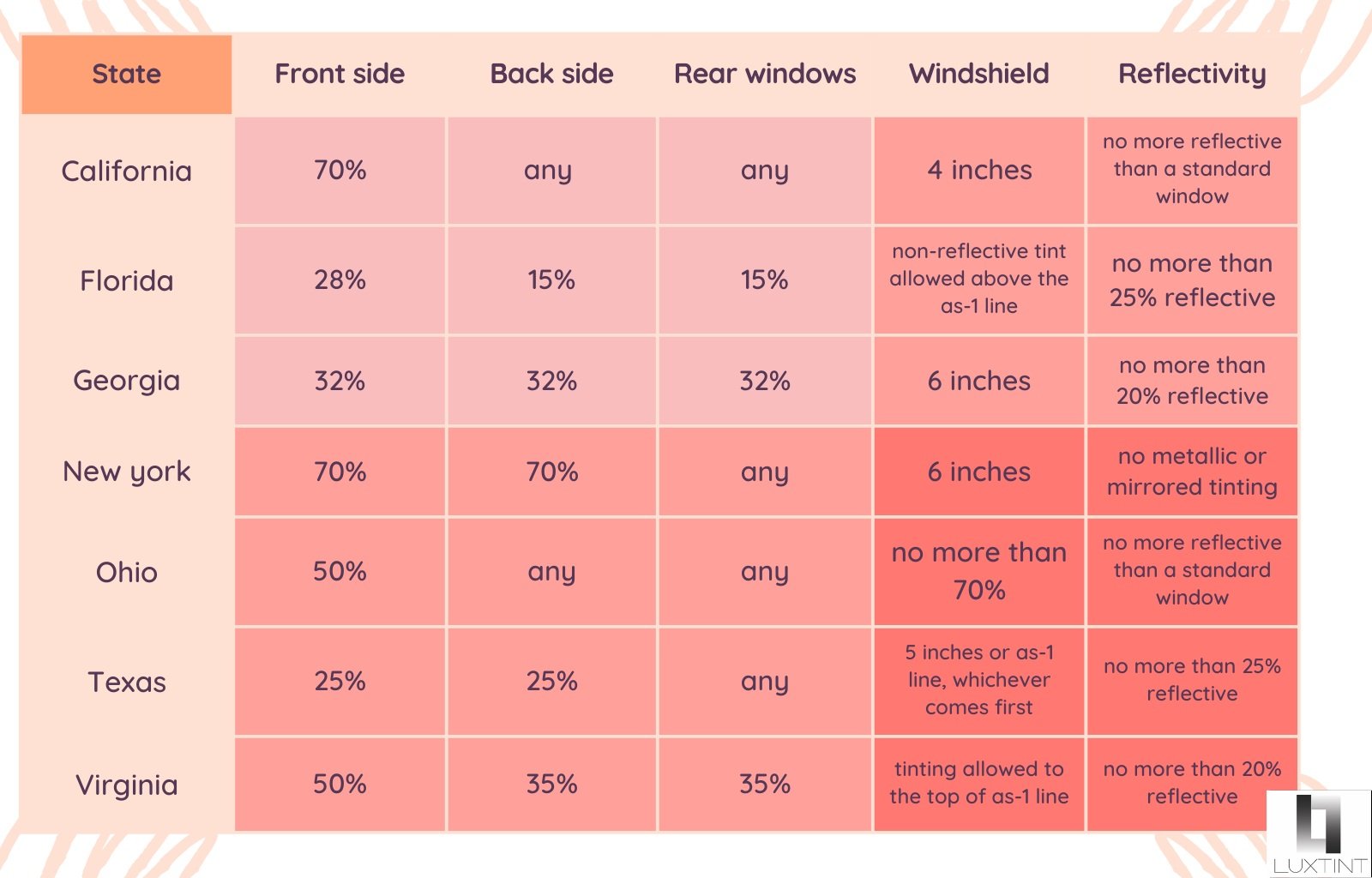The Legality of Window Tinting in Different US States: What You Need to Know
Window tint—it's that dark shade you see on car windows.
Ever wondered why cars have them? Or why some cars have darker tints than others?
Well, there are rules about it. Different places have different rules. "Window tint" is not just about giving your car a stylish look; it's also about safety and comfort.
This guide will give you the lowdown on "window tint," why it's important, and also the rules in California. Before you plan to tint your car windows, get through this guide for better clarity.
Why Do Tint Laws Exist?
So, why are there rules about window tint? Well, it's for a couple of good reasons.
1. Safety First: Imagine you're driving at night, and a car with super dark windows is beside you. It's tough to see if the driver is signaling or even looking your way. Lighter tints let others see through and understand the driver's intentions better.
2. Protection: Window tint isn't just about style. It protects you from the sun's harsh rays. It acts as sunglasses for your car! But too dark, and it could be harmful inside if you can't see well.
3. Uniformity: If every car had different tints—it would be chaos on the road! Rules help keep things uniform and safe.
Having tint rules means everyone stays safer on the road, and drivers can enjoy the benefits of tint without going overboard.
General Terminology Explained
Before we jump into laws, let’s get clear with some terminologies.
Here are some cool words related to window tint, that help you be on the same page!
1. VLT% (Visible Light Transmission %): It is like sunglasses. Some are super dark, and some are lighter. The VLT% is like that but for your car windows. It tells us how much light can come through the tint. A high VLT% means it's lighter, and a low one means it's darker.
2. Limo Tint: You've probably seen those fancy limousines with super dark windows, right? That's called "limo tint." It's mostly used for privacy, but in many places, it's too dark for regular cars.
3. Reflectivity: Ever seen a window that looks shiny from the outside? That's because of reflectivity. Some tints can bounce light off, making them look shiny or mirror-like.
4. Medical Exemption: Some people need darker tints for health reasons. For them, there's something called a medical exemption. It's like a special permission slip that lets them have darker windows.
By understanding these terms, you can make better choices about window tint and know what we're talking about!
Breakdown of Tint Laws by Region
In the world of window tint, rules vary depending on where you are. Different places have different views on how dark or light the tint should be.
Let's take a peek at what some regions say and then specific to California:
A. General U.S. Window Tint Laws
In most states across the U.S., the rules about window tint focus on safety.
After all, drivers need to see out of their cars, and other drivers and pedestrians need to see in!
Front Windows:
The front windows are all about visibility. It's where the driver and co-pilot (or navigator, if you prefer) sit. They need the best view of the world outside to keep things safe.
Most states keep the VLT% for these windows between 50% to 70%. This balance ensures enough light gets in, so our pals driving can see everything clearly.
But, there's still enough tint to protect them from glaring sun or nosy onlookers.
Rear Windows:
When it comes to the rear windows, things get a bit more chill. This is the zone for backseat passengers, luggage, and maybe a furry friend or two.
Many states are more lenient here, allowing for darker tints. It provides passengers more privacy and ensures the sun doesn't disturb your cat's nap or make your chocolate meltWindshield:
Your windshield is like the glasses you wear. It needs to be crystal clear, with only a tiny shade allowed on the top, like a stylish sun visor.
Most states agree that only the top few inches, usually 4 to 6, can have some shade. This little tint helps when the sun's right in front, giving the eyes a small break without causing a view-block.
Varied Tints and Transitions:
While the above are general trends, remember each state has its flavor. Some might allow metallic or mirrored tints, while others strictly say no. A few regions might let you go darker if you have medical reasons.
Some states might check your tint during regular vehicle inspections, while others only when there's a reason. Always good to check local laws if you're thinking of a tint job or traveling with a tinted car.
Here are some main states and their percentages for tints.
B. California Window Tint Laws
California's sunny shores and highways come with specific window tint rules. For your car's front windshield and front side windows, a 70% Visible Light Transmission (VLT) is required, which means they must allow 70% of light in. Rear and back side windows, however, have more freedom, but with a catch: if your rear window is tinted, you need dual side mirrors.
Don't forget about the Window Film Certificate. If you have tinted windows in California, you're required to carry a signed certificate from the tint film manufacturer or installer confirming the tint's VLT percentage.
Considering updates can happen, it's always a smart move to periodically check with the California DMV. They have the most accurate and up-to-date info on tint laws, ensuring you're always on the right side of the rules.
Wrap up
Being informed and aware of the rules can make a big difference. While it's valuable to understand the basics, there's no substitute for professional expertise.
If you're considering adding or updating the tint on your vehicle, always consult with a window tinting specialist. Their knowledge and experience will ensure your car looks great, feels comfortable, and most importantly, complies with all the necessary regulations.

